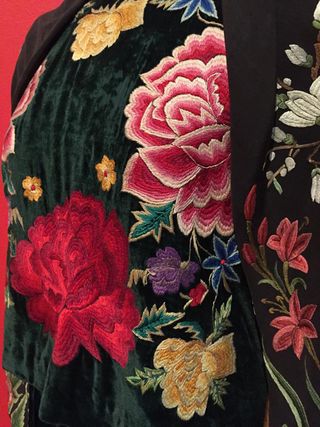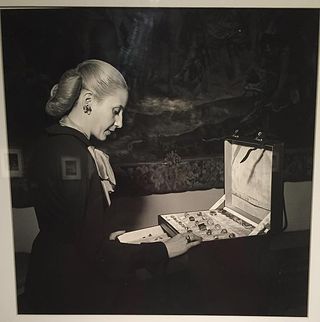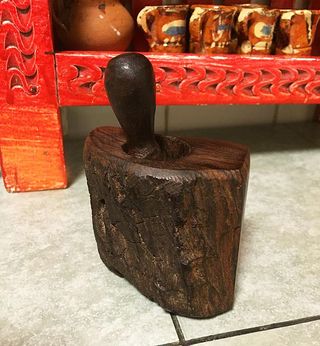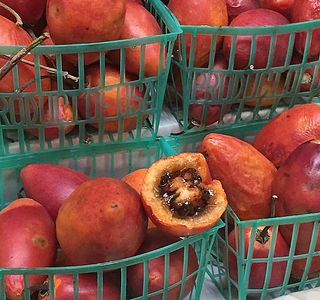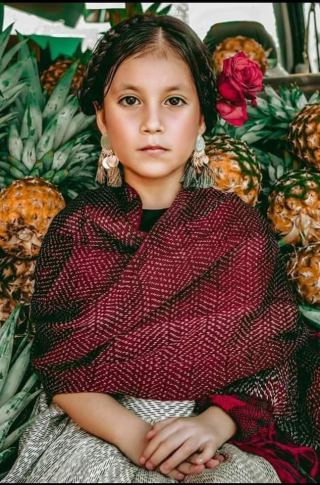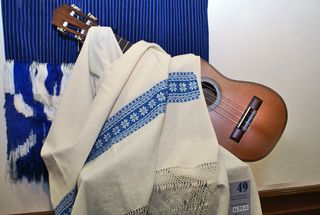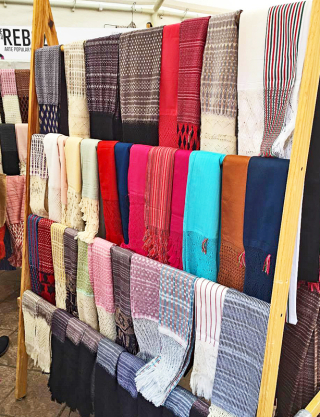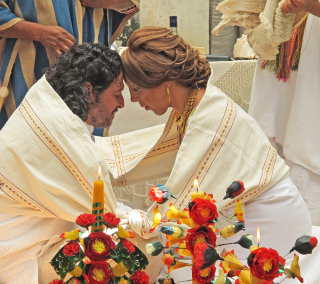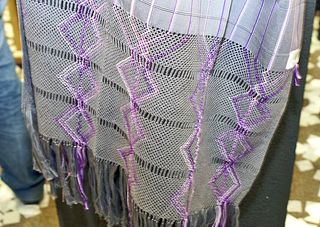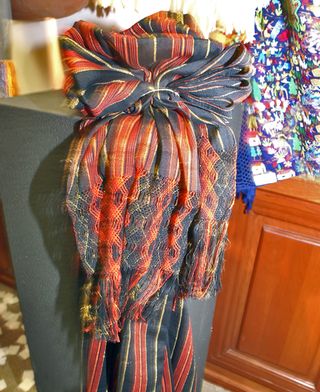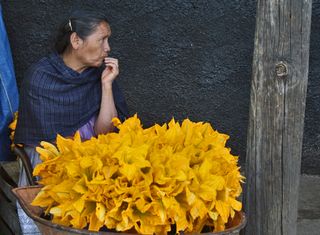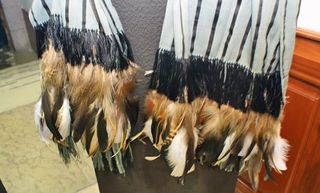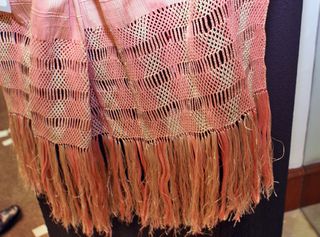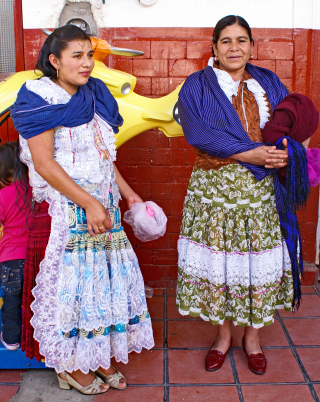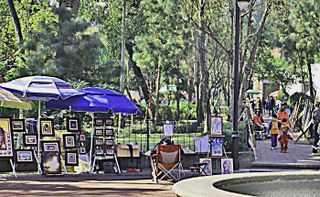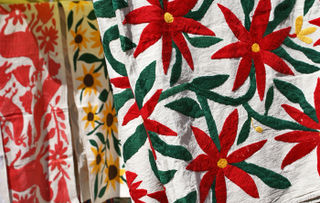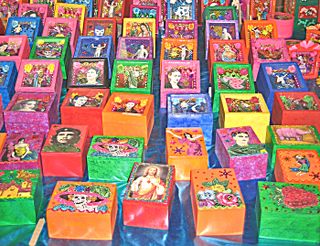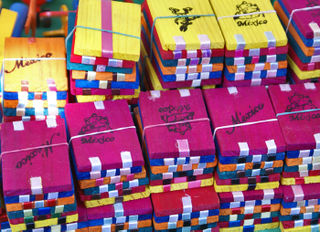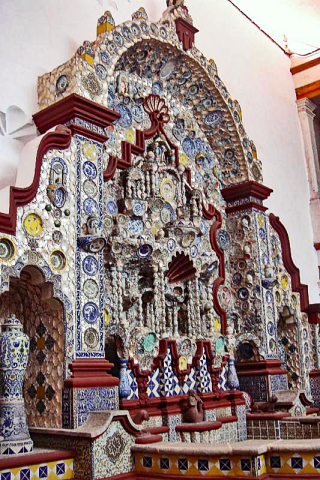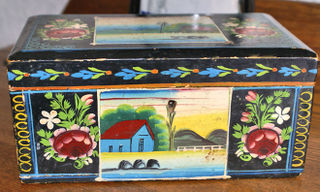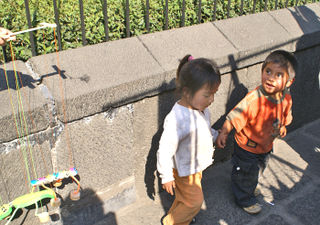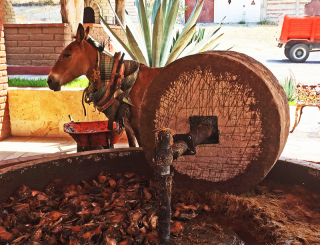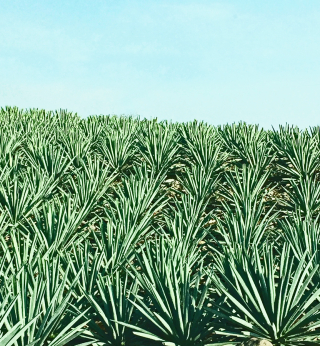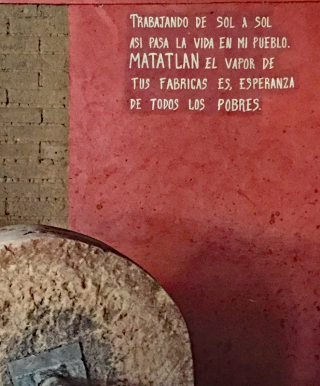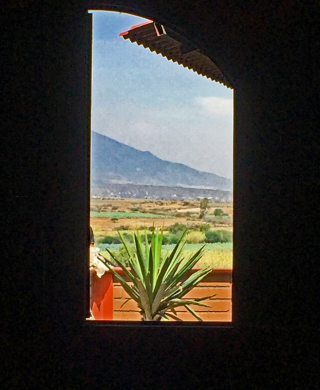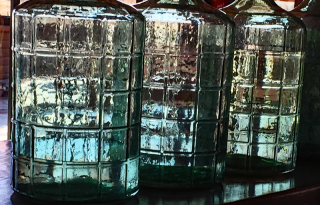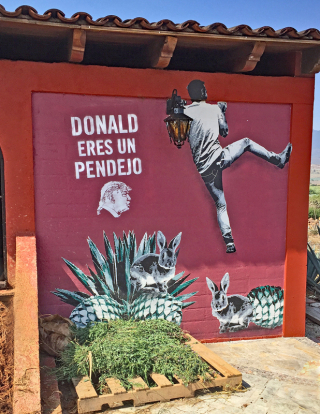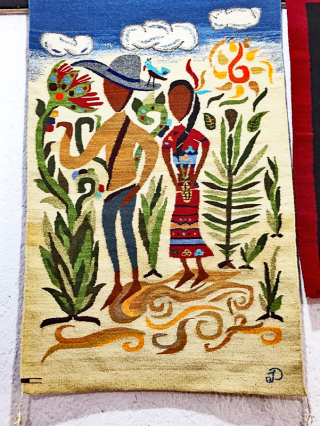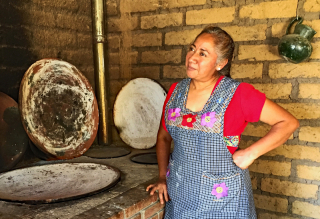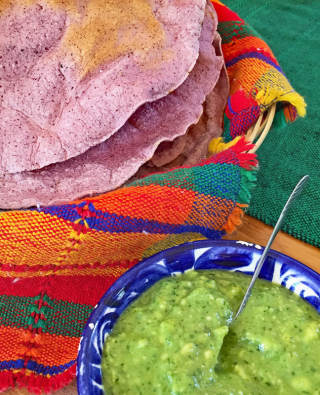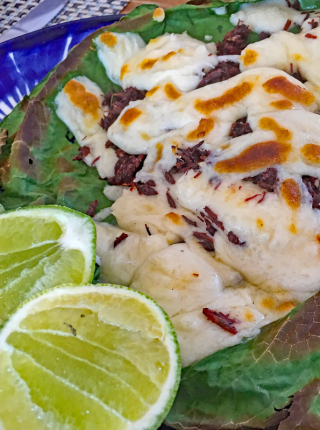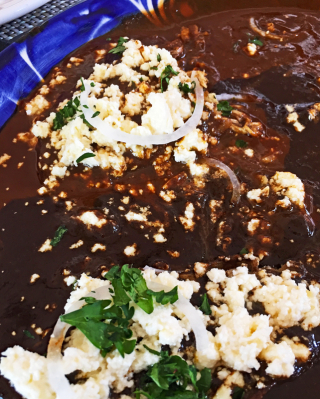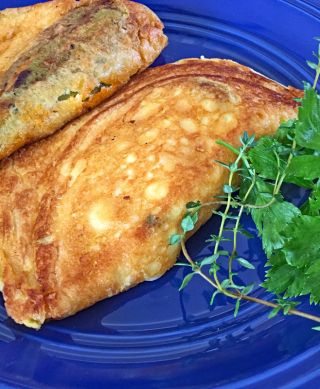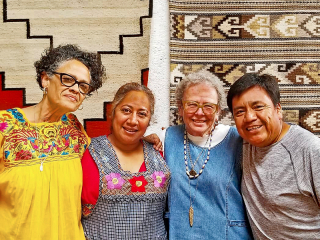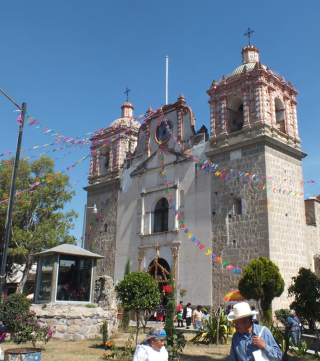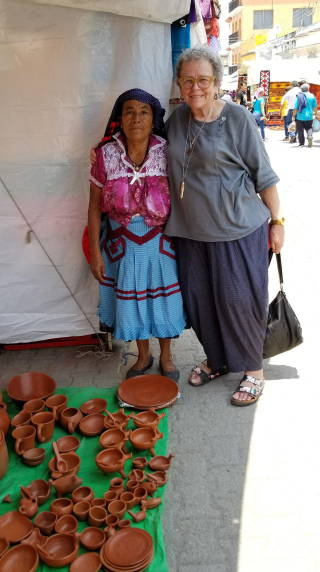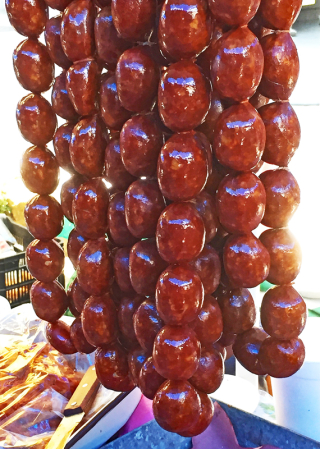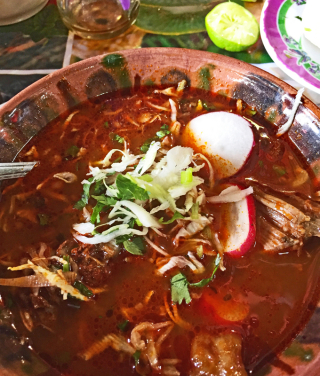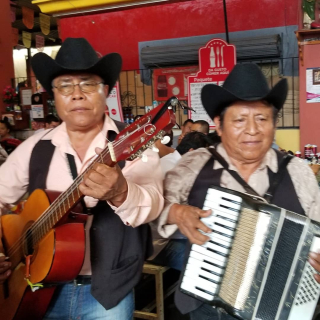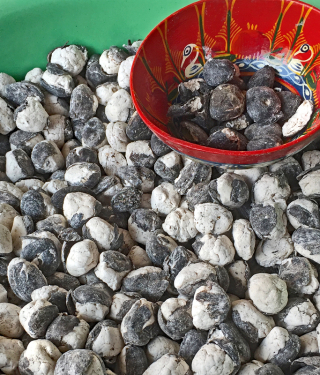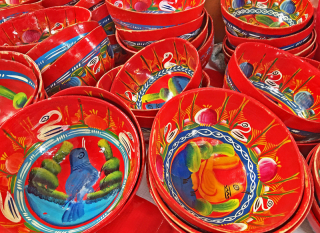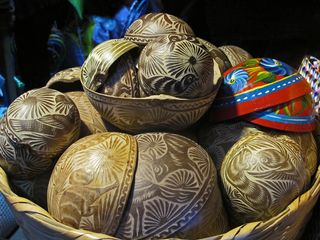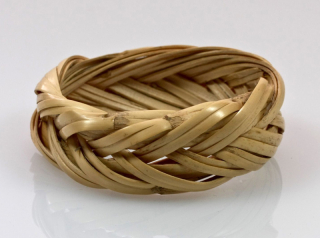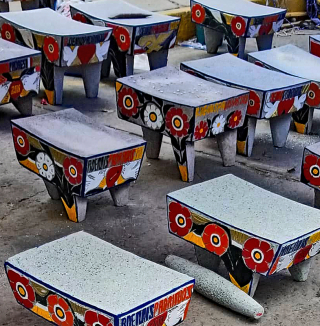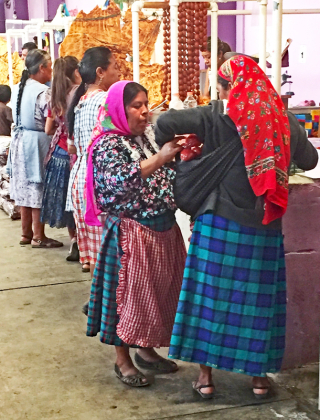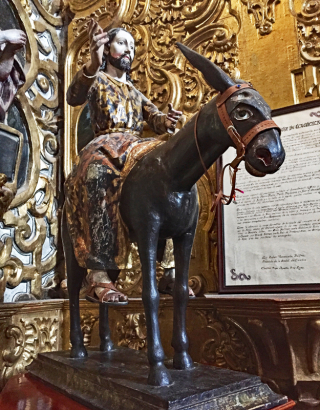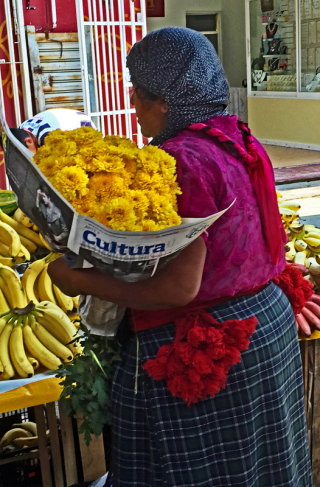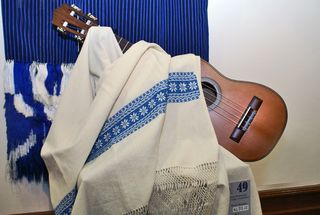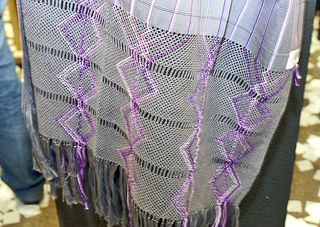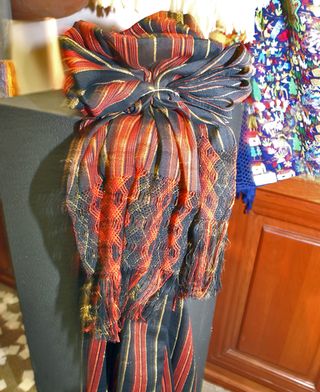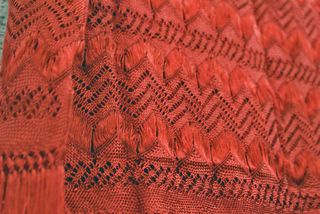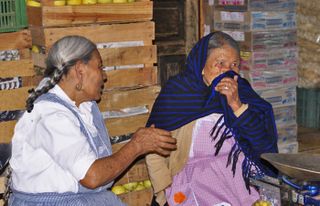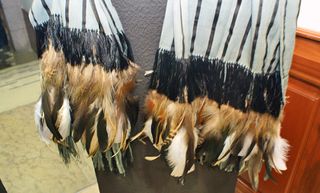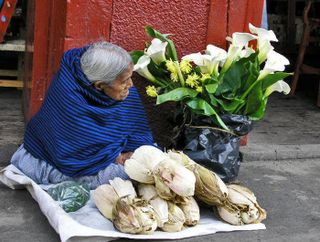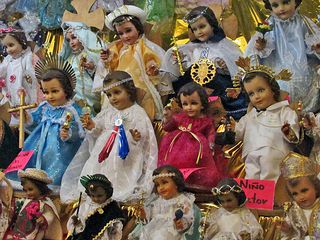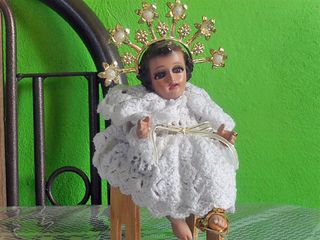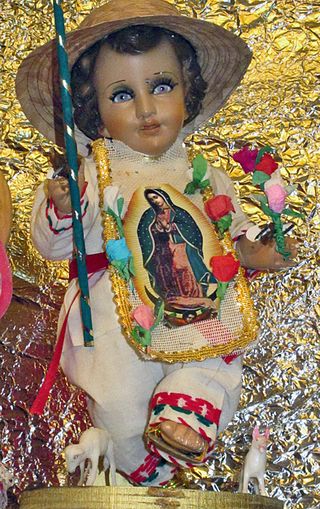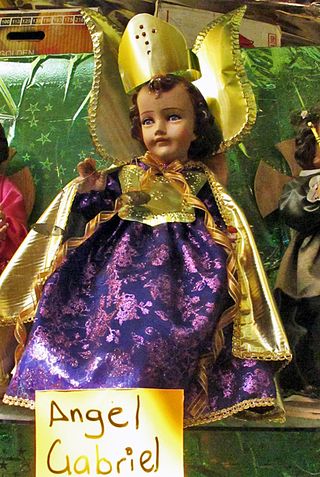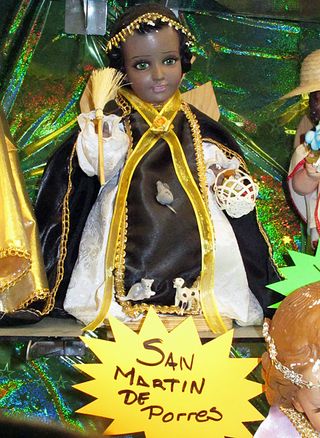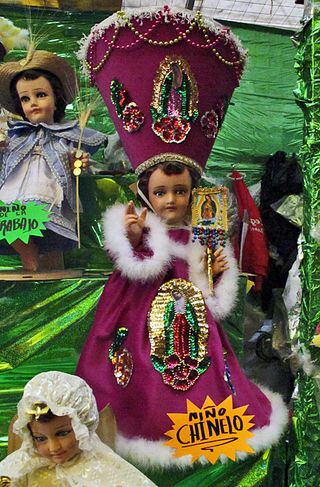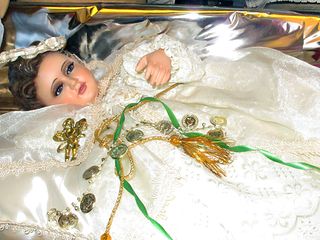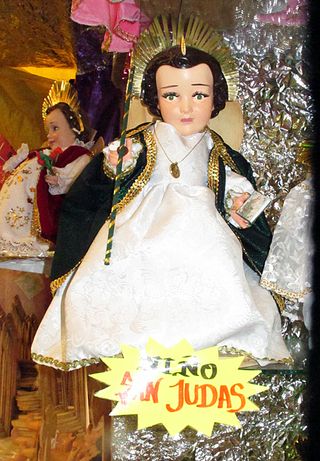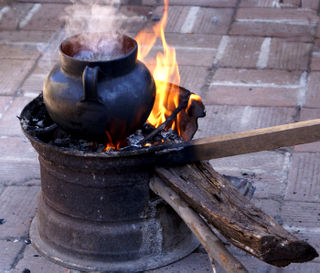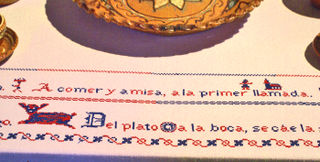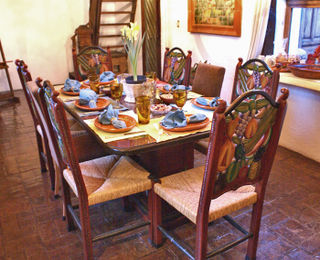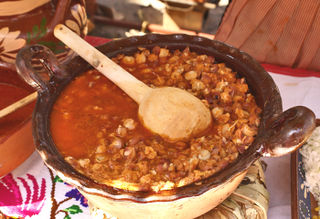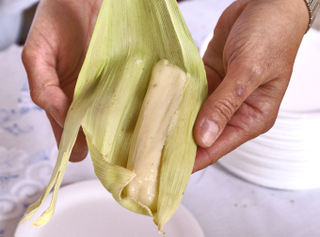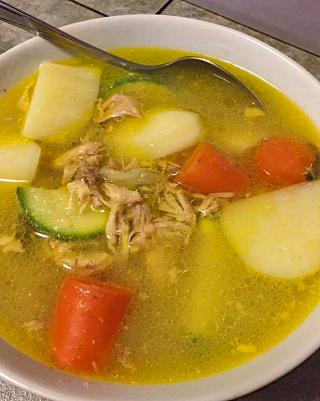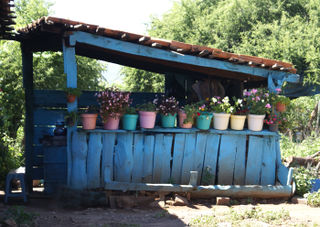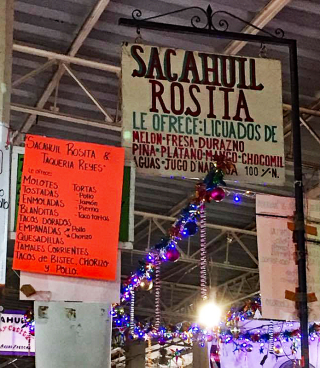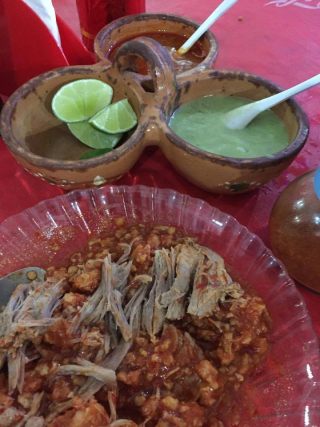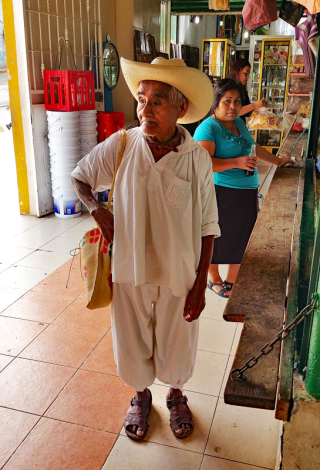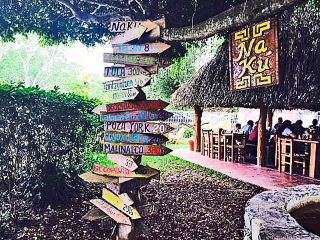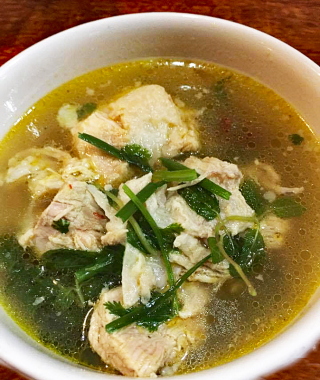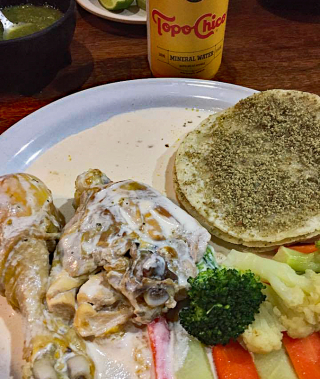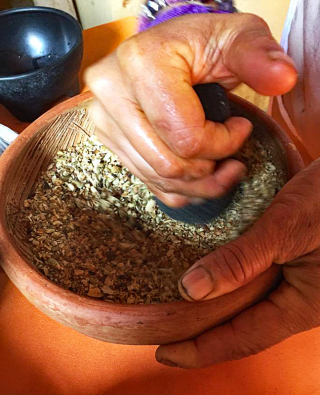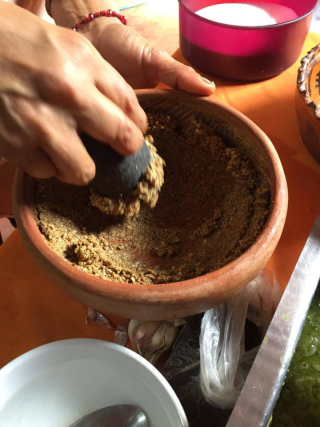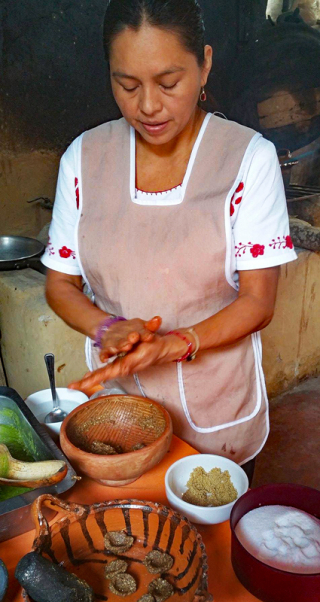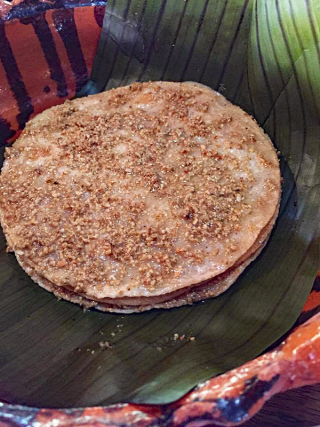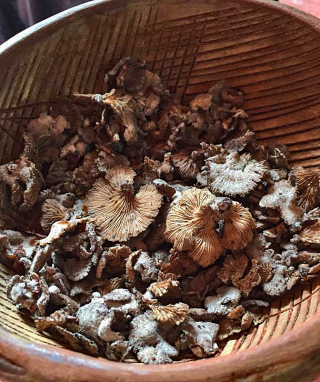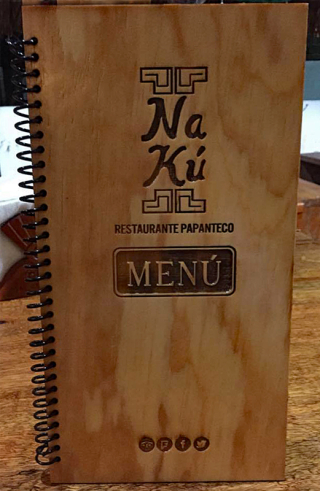
As we drove through Tehuantepec, we were looking for a nearby comida of fresh seafood and had no idea where to go; we stopped to ask a taxi driver and he led us to Salina Cruz, to a beach restaurant that was his favorite. Salina Cruz, Oaxaca: wide open beaches, surfing, seafood! This seaside city of approximately 24,000 people is only about half an hour south and west of Tehuantepec. Salina Cruz is the third largest city in Oaxaca and is a major port in southern Mexico. Its main industry is the enormous oil refinery that one can see from almost everywhere in the area.

He led us to Restaurante Delicias del Mar (Delicacies from the Sea), right on the beach in an area called Las Escolleras (the breakwaters). That's chef Silvana Salcido Esparza (Barrio Cafe Phoenix) at the restaurant doorway, and you can see the incredible stretch of beach behind her–and beyond the beach, the open sea. And may I say that it was hot, hot, hot–around 108ºF–and intensely humid. Salina Cruz is known for its frequently high winds, though, and a stiff breeze helped the comfort level. Inside the restaurant the high, shady palapa roof kept the breeze flowing.
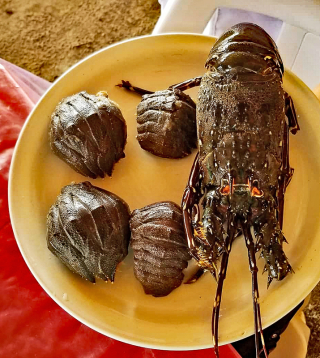
At the right of the plate is the kind of clawless langosta (lobster) caught in the Salina Cruz area. To the left of the lobster (which we ordered) are four cucarachas de mar (sea cockroaches), which we ordered despite their completely unappealing name and appearance. The lobster was excellent and the flesh of the cucarachas was delicious; after cooking, the texture as well as the flavor are similar to those of lobster tail. Who knew!

"Silvana, hold up the huachinango (red snapper) so I can take a picture of it!" I thought she'd hold it up on the plate, but this was far more fun. Whole, slashed, and fried till the skin is crispy and the flesh is moist and delicious–my favorite preparation of red snapper. We left only the skeleton.

The word "salina" means salt lagoon. High tides bring abundant sea water into marked-off areas like the one you see in the photograph, and the intense sunlight dries the water, leaving salt that workers harvest from any remaining water. For many generations, the entire region around Salina Cruz has benefited economically from the salt. After I took this photo, I was amazed to see the clear reflection of the hill in the water. Click on any photo to enlarge it for a better view.
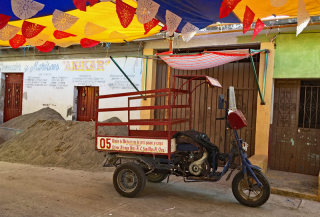
The motocarro (three-wheeled taxi) transportation in San Blas Atempa, where we went after we finished our comida in Salina Cruz. The piles of sand are building materials for earthquake damage repairs.
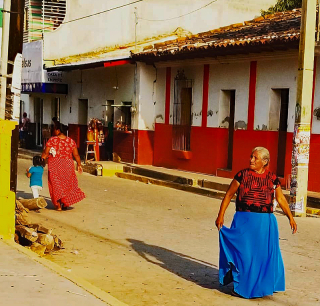
Daily dress, daily life in San Blas Atempa. The town, founded in 1530, feels like a trip to Oaxaca's past. The community speaks Zapotec; the population is descended from a warrior race that takes much pride in preserving its traditions, customs, and language. The townswomen received us with great good humor and much shared laughter. We were sent to a street party down the street and around the block, sponsored by DIF (Desarrollo Integral de la Familia, Mexico's state and national social service agency). It was el Día del Niño (Children's Day) in Mexico, celebrated to the max all over the country. How could we resist!
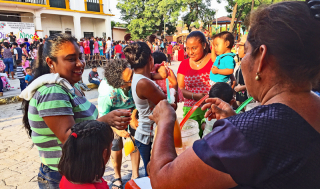
Of course we went! The party vibrated with music, dancing, a funny clown, games and prizes for all of the many children, babies to nuzzle–we had a great time. Chef Silvana saw to it that every child in our proximity received a big cold glass of home-made agua fresca made with fresh fruit: healthy, refreshing, and delicious.

Home-made aguas frescas at the DIF party. Left to right: guayaba (guava), limón (Key lime), and wow, ciruela criolla (native wild plum)! It's my all-time favorite, only available during the short wild plum season in the spring. See the plastic bag between the jar of agua de limón and the jar of plum (orange ladle)? The bag is filled with my serving of agua fresca de ciruela, a straw is stuck into the bag, and the opening of the bag is twisted and tied tightly around the straw. It's the typical Mexican way of sending you off with any kind of soft drink to go.

A bucket of agua fresca de ciruela criolla, to replenish the vitrolero (large glass jar) as needed. The plums are about two inches long, and inch and a half in diameter. The pulp is minimal but delicious. The stone is almost as big as the entire plum.
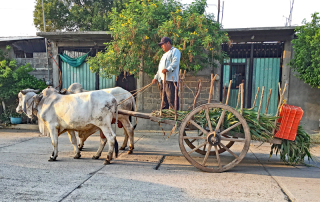
Oxcart is another much-used mode of transportation in San Blas Atempa. We saw probably 20 of these, always with the driver standing up. Occasionally other workmen w
ere riding on the tail end.
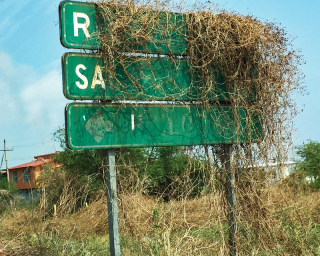
There was a time when most signage in Mexico (if it existed at all) looked just like this, or was hidden behind a tree, or obscured behind a billboard, or was broken in half. Chef Silvana and I are old Mexico hands and immediately recognized that we were on the right track for San Mateo del Mar. We didn't know how many kilometers away it was, though. Turns out that it wasn't far at all, just a few minutes from where we saw the sign.
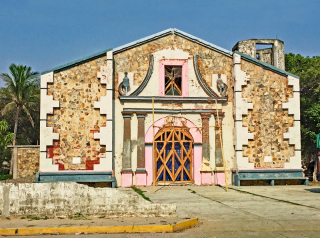
Parroquia de San Mateo Apóstol, San Mateo del Mar, Oaxaca. The brown part of the facade is a design, but much of the church was damaged in the September 7, 2018 earthquake. If you click on the photo to enlarge it, you'll be able to see how the facade continues to be propped up and where there is other damage.
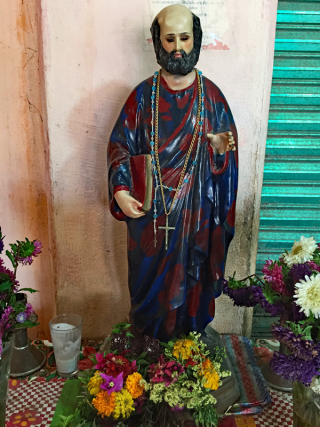
San Mateo Apóstol with flowers and a candle, patron saint of San Mateo del Mar, in a niche in the market.
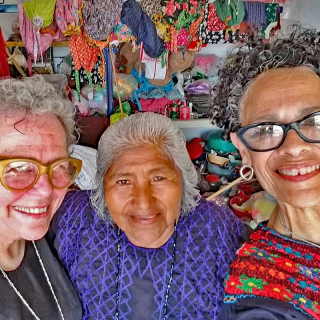
Doña Agustina Sánchez, who sells a little bit of everything in the San Mateo del Mar market. Chef Silvana and I spent a long time talking with her. Hearing her wisdom was a particularly wonderful part of our day. We laughed a lot, cried a little, and loved being there with her. Doña Agustina gave each of us a shell necklace and her blessing when we left.
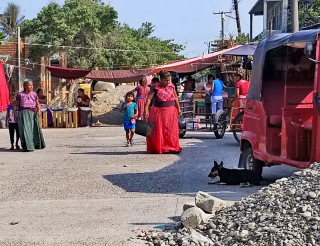
We happened to be in San Mateo for its día de plaza (market day). The market is broken up into several sections because of earthquake damage to streets and homes; you can see the piles of both rubble (bottom right) and sand for new construction (middle left). There was produce and other food available for purchase, but many, many of the community's houses were destroyed by the earthquake and many people continue to be without a place to live and a fixed place and way to cook.

Earthquake damage in San Mateo del Mar. Photo courtesy Oaxaca news sources.
The Huave indigenous population of San Mateo del Mar and its surrounding region is known in the community's own language as ikoots (it means "us"), and in Spanish the people often call themselves mareños, or people of the sea. They have lived in this tiny area of Oaxaca for more than 3000 years, predating the Zapotec population and obviously predating the arrival of the Spanish. Men of the community have always been fishermen, and many of the women have been weavers since pre-hispanic times. The Huave speak four distinct varieties of their language in their various communities; some of their Huave languages aren't understood by other Huave-speakers. The total population of this ethnicity is approximately 29,000, divided into five towns: San Mateo del Mar, San Dionisio del Mar, San Francisco del Mar, and Santa María del Mar. All are seaside villages or small towns; San Mateo del Mar has the largest population, with about 12,000 people.

Most of these typical Huave homes were destroyed by the September 7, 2017 earthquake. Many other homes, with stick walls made of carrizo (similar to bamboo) and thatched roofs, were also either flattened or otherwise made uninhabitable. Chef Silvana and I had the privilege of being invited into one of the carrizo homes and could see first hand the living conditions caused by the quake.
As we drove into San Mateo del Mar, a tiny black sign with white lettering, above the door of a house, caught my eye. In Spanish, it read: "Woven things sold here." We braked fast and backed up to the corner to park. As we walked through sand to the house, a very young woman with a baby on her hip came out to greet us. "Buscan tejidos?" (
'Are you looking for weavings?') She got in the car with the baby and guided us a few hundred feet down the road, where we parked in front of another house, built of sticks and with a thatched roof. You can see part of the inside in the video below.
[youtube=https://www.youtube.com/watch?v=-UkxPawYhN0&w=400&h=315]
In the video, the woman weaving with a back strap loom is Elena Villaseñor Rangel, a daughter of Sra. Justina Oviedo Rangel. Doña Justina passed away in September 2013; her three daughters (Cristina, Victoria, and Elena Villaseñor Rangel) are carrying on her weaving tradition. You can see parts of the house, as well as our young 'guide', taking various types of textiles from a bag.
We were extremely fortunate to have found Doña Justina's relatives, who told us a little of her story. Born in 1938 and raised in San Mateo del Mar, she–like all the girls of her village–wasn't encouraged to go to school. She started weaving when she was just eight years old, initially practicing with palm leaves and soon picking up any bits of thread she could find to use for her child-like projects. She wasn't formally taught to weave; she learned by observing the women of her family. She became more and more proficient at her craft and gained some recognition as a weaver. Years of weaving later, she began to think about the "blank" side of a napkin; the design was always woven onto the front, and the reverse was blank. She announced to her daughters that she was going to figure out a way to weave a design on both sides of a single layer. Her daughters pretty much said, "Yeah right." It seemed like an impossible task, and was something that had never been thought of, much less done. Doña Justina kept trying until she figured it out.
In those days, there was very little market outside San Mateo del Mar for ikoots textiles. Doña Justina sold the textiles she wove then to women in the town. Today, the servilletas (cloths for wrapping tortillas), rebozos (long rectangular "shawls" used for everything from carrying babies to carrying wood), and huipiles (traditional women's blouses and dresses) made in the village are coveted by museums, individual collectors, and just about anyone who sees them. Doña Justina has been honored many, many times for her fine work and for her impact on the town and its weavers.

Chef Silvana standing next to a poster for an homenaje (homage) that was to be given in honor of doña Justina the day after we had to leave Oaxaca. We were so disappointed not to be able to go. Silvana is wearing a just-purchased huipil made from a fabric very similar to the fabric that you saw being woven in the video above.
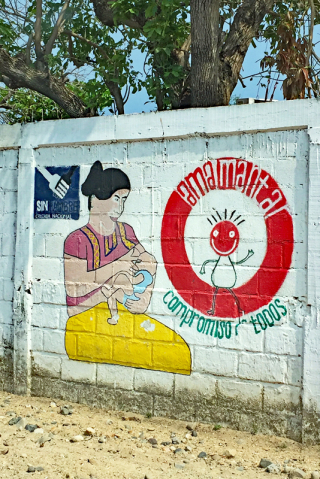
Poster in San Mateo del Mar promoting breastfeeding. "Amamantar Compromiso de Todos" (Breastfeeding is a Commitment for All).
Next week, Silvana and I head back to the city of Oaxaca to catch a plane back to Mexico City. On the way to the city, we get to have two more wonderful experiences: a visit to the Ilegal mezcal operations in Matatlán, and comida at the home of cocinera tradicional Carina Santiago Bautista and her husband, extraordinary weaver Pedro Moreno, in Teotitlán del Valle. Come with us!
Looking for a tailored-to-your-interests specialized tour in Mexico? Click here: Tours.

